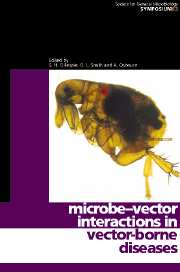Book contents
- Frontmatter
- Contents
- Contributors
- Editors' Preface
- 1 Vector-borne diseases
- 2 Evolution of tick-borne disease systems
- 3 Insect transmission of viruses
- 4 RNA-based immunity in insects
- 5 Specificity of Borrelia–tick vector relationships
- 6 Bunyavirus/mosquito interactions
- 7 How do mosquito vectors live with their viruses?
- 9 Vector competence
- 9 Environmental influences on arbovirus infections and vectors
- 10 Vector immunity
- 11 Transmission of plant viruses by nematodes
- 12 Wolbachia host–symbiont interactions
- 13 Pathogenic strategies of Anaplasma phagocytophilum, a unique bacterium that colonizes neutrophils
- 14 Interactions of Yersinia pestis with its flea vector that lead to the transmission of plague
- 15 Transgenic malaria
- 16 Vaccines targeting vectors
- Index
6 - Bunyavirus/mosquito interactions
Published online by Cambridge University Press: 06 July 2010
- Frontmatter
- Contents
- Contributors
- Editors' Preface
- 1 Vector-borne diseases
- 2 Evolution of tick-borne disease systems
- 3 Insect transmission of viruses
- 4 RNA-based immunity in insects
- 5 Specificity of Borrelia–tick vector relationships
- 6 Bunyavirus/mosquito interactions
- 7 How do mosquito vectors live with their viruses?
- 9 Vector competence
- 9 Environmental influences on arbovirus infections and vectors
- 10 Vector immunity
- 11 Transmission of plant viruses by nematodes
- 12 Wolbachia host–symbiont interactions
- 13 Pathogenic strategies of Anaplasma phagocytophilum, a unique bacterium that colonizes neutrophils
- 14 Interactions of Yersinia pestis with its flea vector that lead to the transmission of plague
- 15 Transgenic malaria
- 16 Vaccines targeting vectors
- Index
Summary
INTRODUCTION
Bunyaviruses comprise the largest family of arthropod-transmitted viruses. Of the 300 or so viruses in the family Bunyaviridae more than half are transmitted by mosquitoes (Calisher, 1996). A number of these viruses cause disease in man or animals, although thus far many have not been associated with human illness. The family is classified into five genera, Orthobunyavirus, Hantavirus, Nairovirus, Phlebovirus and Tospovirus, and each genus is associated with a principal arthropod vector, except the hantaviruses, which have no arthropod involvement in their life cycle. Tospoviruses are transmitted by thrips to plants, nairoviruses primarily by ticks, and orthobunyaviruses predominantly by mosquitoes. The Phlebovirus genus contains viruses transmitted by phlebotomine flies, ticks and, notably for Rift Valley fever virus, mosquitoes as well. This chapter will deal with the interactions between orthobunyaviruses and mosquitoes.
BUNYAVIRUS CHARACTERISTICS
All bunyaviruses have a tri-segmented single-stranded RNA genome of negative-sense (or a variant of negative-sense, termed ambisense) polarity. The genomic RNA segments are called L (large), M (medium) and S (small). All family members encode four structural proteins – two glycoproteins called Gn and Gc according to their position within the primary gene product, a nucleoprotein, N, that encapsidates the genomic (and antigenomic) RNA segments and an RNA-dependent RNA polymerase, called L protein. The pattern of sizes of the viral proteins and the RNAs is conserved within a genus (Elliott et al., 2000). Viruses in some genera also encode non-structural proteins on their M and/or S RNA segments, termed NSm and NSs, respectively.
- Type
- Chapter
- Information
- Microbe-vector Interactions in Vector-borne Diseases , pp. 91 - 102Publisher: Cambridge University PressPrint publication year: 2004

